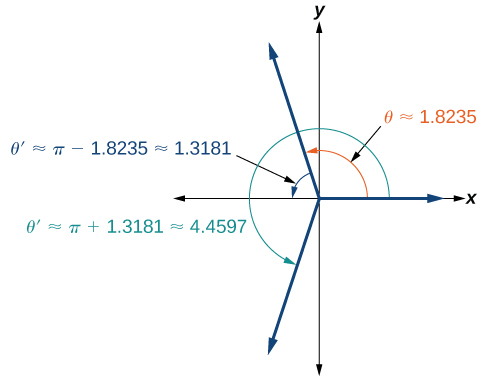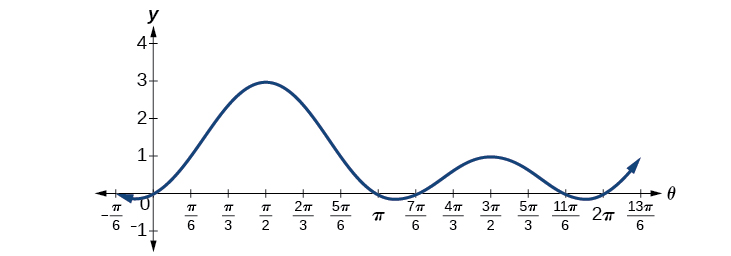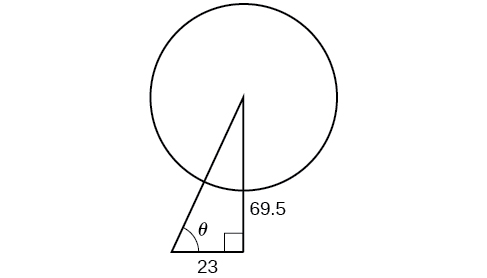9.5: Solving Trigonometric Equations
( \newcommand{\kernel}{\mathrm{null}\,}\)
- Solve linear trigonometric equations in sine and cosine.
- Solve equations involving a single trigonometric function.
- Solve trigonometric equations using a calculator.
- Solve trigonometric equations that are quadratic in form.
- Solve trigonometric equations using fundamental identities.
- Solve trigonometric equations with multiple angles.
- Solve right triangle problems.
Thales of Miletus (circa 625–547 BC) is known as the founder of geometry. The legend is that he calculated the height of the Great Pyramid of Giza in Egypt using the theory of similar triangles, which he developed by measuring the shadow of his staff. Based on proportions, this theory has applications in a number of areas, including fractal geometry, engineering, and architecture. Often, the angle of elevation and the angle of depression are found using similar triangles.

In earlier sections of this chapter, we looked at trigonometric identities. Identities are true for all values in the domain of the variable. In this section, we begin our study of trigonometric equations to study real-world scenarios such as the finding the dimensions of the pyramids.
Solving Linear Trigonometric Equations in Sine and Cosine
Trigonometric equations are, as the name implies, equations that involve trigonometric functions. Similar in many ways to solving polynomial equations or rational equations, only specific values of the variable will be solutions, if there are solutions at all. Often we will solve a trigonometric equation over a specified interval. However, just as often, we will be asked to find all possible solutions, and as trigonometric functions are periodic, solutions are repeated within each period. In other words, trigonometric equations may have an infinite number of solutions. Additionally, like rational equations, the domain of the function must be considered before we assume that any solution is valid. The period of both the sine function and the cosine function is
There are similar rules for indicating all possible solutions for the other trigonometric functions. Solving trigonometric equations requires the same techniques as solving algebraic equations. We read the equation from left to right, horizontally, like a sentence. We look for known patterns, factor, find common denominators, and substitute certain expressions with a variable to make solving a more straightforward process. However, with trigonometric equations, we also have the advantage of using the identities we developed in the previous sections.
Find all possible exact solutions for the equation
Solution
From the unit circle, we know that
These are the solutions in the interval
where
Find all possible exact solutions for the equation
Solution
Solving for all possible values of
where
- Look for a pattern that suggests an algebraic property, such as the difference of squares or a factoring opportunity.
- Substitute the trigonometric expression with a single variable, such as
- Solve the equation the same way an algebraic equation would be solved.
- Substitute the trigonometric expression back in for the variable in the resulting expressions.
- Solve for the angle.
Solve the equation exactly:
Solution
Use algebraic techniques to solve the equation.
Solve exactly the following linear equation on the interval
- Answer
-
Solving Equations Involving a Single Trigonometric Function
When we are given equations that involve only one of the six trigonometric functions, their solutions involve using algebraic techniques and the unit circle (see [link]). We need to make several considerations when the equation involves trigonometric functions other than sine and cosine. Problems involving the reciprocals of the primary trigonometric functions need to be viewed from an algebraic perspective. In other words, we will write the reciprocal function, and solve for the angles using the function. Also, an equation involving the tangent function is slightly different from one containing a sine or cosine function. First, as we know, the period of tangent is
Solving a Problem Involving a Single Trigonometric Function
Solve the problem exactly:
Solution
As this problem is not easily factored, we will solve using the square root property. First, we use algebra to isolate
Solve the following equation exactly:
Solution
We want all values of
Analysis
As
Solve the equation exactly:
Solution
Recall that the tangent function has a period of
Over the interval
Find all solutions for
- Answer
-
Identify all exact solutions to the equation
Solution
We can solve this equation using only algebra. Isolate the expression
There are two angles on the unit circle that have a tangent value of
Solve Trigonometric Equations Using a Calculator
Not all functions can be solved exactly using only the unit circle. When we must solve an equation involving an angle other than one of the special angles, we will need to use a calculator. Make sure it is set to the proper mode, either degrees or radians, depending on the criteria of the given problem.
Use a calculator to solve the equation
Solution
Make sure mode is set to radians. To find
The solution is
The angle measurement in degrees is
Analysis
Note that a calculator will only return an angle in quadrants I or IV for the sine function, since that is the range of the inverse sine. The other angle is obtained by using
Use a calculator to solve the equation
Solution
We can begin with some algebra.
Check that the MODE is in radians. Now use the inverse cosine function
Since

So, we also need to find the measure of the angle in quadrant III. In quadrant III, the reference angle is
The solutions are
Solve
- Answer
-
Solving Trigonometric Equations in Quadratic Form
Solving a quadratic equation may be more complicated, but once again, we can use algebra as we would for any quadratic equation. Look at the pattern of the equation. Is there more than one trigonometric function in the equation, or is there only one? Which trigonometric function is squared? If there is only one function represented and one of the terms is squared, think about the standard form of a quadratic. Replace the trigonometric function with a variable such as
Solve the equation exactly:
Solution
We begin by using substitution and replacing
The equation cannot be factored, so we will use the quadratic formula:
Replace
Note that only the + sign is used. This is because we get an error when we solve
This terminal side of the angle lies in quadrant I. Since cosine is also positive in quadrant IV, the second solution is
Solve the equation exactly:
Solution
Using grouping, this quadratic can be factored. Either make the real substitution,
Next solve for
Analysis
Make sure to check all solutions on the given domain as some factors have no solution.
Solve
- Answer
-
Solve exactly:
Solution
This problem should appear familiar as it is similar to a quadratic. Let
Then, substitute back into the equation the original expression
The solutions within the domain
If we prefer not to substitute, we can solve the equation by following the same pattern of factoring and setting each factor equal to zero.
Analysis
We can see the solutions on the graph in Figure

We can verify the solutions on the unit circle in via the result in the section on Sum and Difference Identities as well.
Solve the equation quadratic in form exactly:
Solution
We can factor using grouping. Solution values of
Solve the quadratic equation
- Answer
-
Solving Trigonometric Equations Using Fundamental Identities
While algebra can be used to solve a number of trigonometric equations, we can also use the fundamental identities because they make solving equations simpler. Remember that the techniques we use for solving are not the same as those for verifying identities. The basic rules of algebra apply here, as opposed to rewriting one side of the identity to match the other side. In the next example, we use two identities to simplify the equation.
Use identities to solve exactly the trigonometric equation over the interval
Solution
Notice that the left side of the equation is the difference formula for cosine.
From the unit circle in the section on Sum and Difference Identities, we see that
Solve the equation exactly using a double-angle formula:
Solution
We have three choices of expressions to substitute for the double-angle of cosine. As it is simpler to solve for one trigonometric function at a time, we will choose the double-angle identity involving only cosine:
So, if
Solve the equation exactly using an identity:
Solution
If we rewrite the right side, we can write the equation in terms of cosine:
Our solutions are
Solving Trigonometric Equations with Multiple Angles
Sometimes it is not possible to solve a trigonometric equation with identities that have a multiple angle, such as
Solve exactly:
Solution
We can see that this equation is the standard equation with a multiple of an angle. If
Therefore, the possible angles are
Are there any other possible answers? Let us return to our first step.
In quadrant I,
In quadrant IV,
so
One more rotation yields
Our solutions are
Solving Right Triangle Problems
We can now use all of the methods we have learned to solve problems that involve applying the properties of right triangles and the Pythagorean Theorem. We begin with the familiar Pythagorean Theorem,
and model an equation to fit a situation.
One of the cables that anchors the center of the London Eye Ferris wheel to the ground must be replaced. The center of the Ferris wheel is

Solution
Use the Pythagorean Theorem (Equation
The angle of elevation is
The angle of elevation is approximately
OSHA safety regulations require that the base of a ladder be placed
Solution
For any length of ladder, the base needs to be a distance from the wall equal to one fourth of the ladder’s length. Equivalently, if the base of the ladder is “a” feet from the wall, the length of the ladder will be

The side adjacent to
The elevation of the ladder forms an angle of
Thus, the ladder touches the wall at
Access these online resources for additional instruction and practice with solving trigonometric equations.
- Solving Trigonometric Equations I
- Solving Trigonometric Equations II
- Solving Trigonometric Equations III
- Solving Trigonometric Equations IV
- Solving Trigonometric Equations V
- Solving Trigonometric Equations VI
Key Concepts
- When solving linear trigonometric equations, we can use algebraic techniques just as we do solving algebraic equations. Look for patterns, like the difference of squares, quadratic form, or an expression that lends itself well to substitution. See Example
- Equations involving a single trigonometric function can be solved or verified using the unit circle. See Example
- We can also solve trigonometric equations using a graphing calculator. See Example
- Many equations appear quadratic in form. We can use substitution to make the equation appear simpler, and then use the same techniques we use solving an algebraic quadratic: factoring, the quadratic formula, etc. See Example
- We can also use the identities to solve trigonometric equation. See Example
- We can use substitution to solve a multiple-angle trigonometric equation, which is a compression of a standard trigonometric function. We will need to take the compression into account and verify that we have found all solutions on the given interval. See Example
- Real-world scenarios can be modeled and solved using the Pythagorean Theorem and trigonometric functions. See Example


